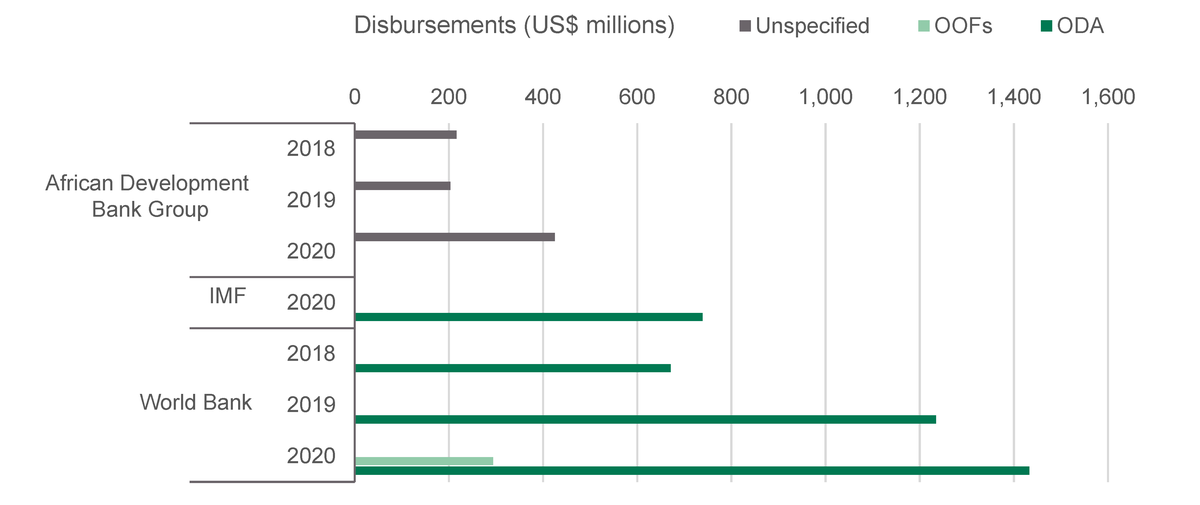Analysis of aid flows to Kenya before and during Covid-19
This briefing analyses aid flows from key donors to Kenya before and during Covid-19.
DownloadsKey findings
The following findings are drawn from analysis of aid flows from key donors. For more information, see our box on International Aid Transparency Initiative (IATI) data.
- Despite growth in international financial institutions (IFIs) disbursements between 2018 and 2020, bilateral and multilateral aid was erratic and characterised by both increases and decreases in contribution over the same period.
- The aid landscape in Kenya is increasingly leaning more towards aid loans than grants. Bilateral grants are decreasing, while loans from IFIs are on the rise.
- The bulk of aid contributed to Kenya by bilateral donors, multilateral donors and IFIs was in the form of official development assistance (ODA) against small volumes of non-concessional finance. ODA contributed by IFIs drove the increase in disbursements to Kenya between 2018 and 2020.
- While five of the 15 bilateral donors that regularly contribute to Kenya increased their contributions between 2018 and 2019, only three donors increased their contributions between 2019 and 2020: European Commission (23.4%), Denmark (15.5%) and Sweden (8.0%).
- The health sector had the biggest share of allocation contributed by bilateral donors in the three years reviewed. However, allocations fell by 31.1% between 2019 and 2020, despite health being the primary sector for use of the ODA grants.
- While IFIs prioritised allocation to the governance and security, agriculture and food security and education sectors in 2020, bilateral donors prioritised health throughout the period reviewed. IFIs’ allocation to these sectors increased consistently between 2018 and 2020, except in the education sector in 2019, which dropped by 45.6%.
- Multilateral donors’ sector prioritisation mirrors that of bilateral donors. Multilateral donors prioritised allocation to the health, humanitarian and agriculture and food security sectors in the three years reviewed.
Introduction
Most sectors in the Kenyan economy are reliant on donor financing to contribute to sector programmes. Donor financing compliments domestic revenue available for sectoral budgeting in almost all the sectors in Kenya.
Obtaining reliable data on current funding flows has always been a challenge. However, improved publishing over the past two years by many bilateral donors, IFIs and multilateral agencies using the International Aid Transparency Initiative (IATI) provides new opportunities. This analysis relies on disbursement data sourced from IATI. It focuses on spend by donor type and flow type, leading institutions and sectoral allocations. The analysis did not use OECD DAC data, because though this data is verified it is not available at country or sector level until January 2022.
It should be noted that the data utilised in the analysis does not present a fully comprehensive picture of the aid situation in Kenya due to poor IATI publishing by some donors. There is, however, sufficient available data – over two-thirds of the total bilateral aid and all of IFI aid – to draw conclusions on how the aid landscape is changing in light of the Covid-19 pandemic and establish some recommendations on how Kenya should manage its aid in the short term.
Box 1
Important note about the aid data used in this report
This analysis relies on data published by donors to IATI, a major source of near real-time disbursements of aid. In this paper, we look at all disbursements – ODA, non-concessional Other Official Flows (OOF) and other flows to show what funding has crossed into the country and how activities on the ground are affected. The data in this report comprises all disbursements made by a consistent set of donors, detailed in Table A1 in the Appendix, for January to December 2018 to 2020, and relies on data published by these donors up until March 2021 (on the basis that most publish their disbursement data within three months of the period in question).
It is possible that more transactions made in 2020 will be published to IATI after this report; however, this is likely to have minimal impact on the findings based on the publishing habits of donors to date. This report therefore provides a picture based on what was published at a single point in time, compared to the same publishing period the year before by the same set of donors. As not all donors publish to IATI, this analysis focuses on how disbursements have changed, rather than total flows.
Disbursements by donor type
While disbursements from IFIs grew substantially between 2018 and 2020, growth of bilateral and multilateral aid was inconsistent in the same period (Figure 1). [1]
Figure 1: Aid disbursements by key bilateral donors, IFIs and multilateral institutions, January to December, 2018 to 2020

| Multilateral | Multilateral | Multilateral | IFIs | IFIS | IFIs | Bilateral | Bilateral | Bilateral | |
|---|---|---|---|---|---|---|---|---|---|
| 2020 | 2019 | 2018 | 2020 | 2019 | 2018 | 2020 | 2019 | 2018 | |
| ODA | 345 | 323 | 349 | 1,432 | 1,235 | 671 | 794 | 989 | 971 |
| OOFs | 16 | 24 | 22 | 294 | 0 | 0 | 14 | 0.01 | 11 |
Source: Development Initiatives based on IATI data.
Notes: IFI = international financial institution, OOFs = Other Official Flows. See Table A1 for the full list of bilateral donors, IFIs and multilateral institutions.
Disbursements by flow type
IFI loans have increased consistently in the period under review, while grants from bilateral donors have declined in the same period (Figure 2). [2]
Figure 2: Aid disbursements by key bilateral donors, IFIs and multilateral institutions by flow type, January to December, 2018 to 2020
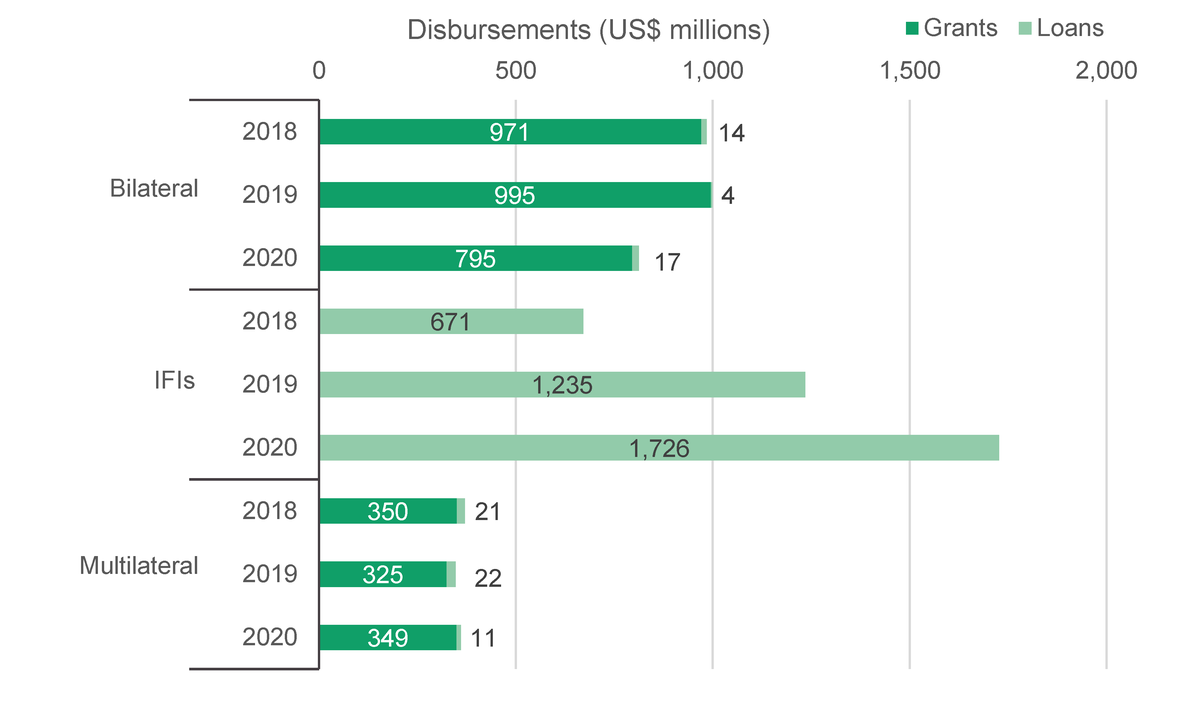
| Multilateral | Multilateral | Multilateral | IFIs | IFIs | IFIs | Bilateral | Bilateral | Bilateral | |
|---|---|---|---|---|---|---|---|---|---|
| 2020 | 2019 | 2018 | 2020 | 2019 | 2018 | 2020 | 2019 | 2018 | |
| Loans | 11 | 22 | 21 | 1,726 | 1,235 | 671 | 17 | 4 | 14 |
| Grants | 349 | 325 | 350 | 0 | 0 | 0 | 795 | 995 | 971 |
Source: Development Initiatives based on IATI data.
Notes: IFI = international financial institution. See Table A1 for the full list of bilateral donors, IFIs and multilateral institutions.
Donors and institutions driving the trends in aid disbursements
International financial institutions
The bulk of the aid contributed by IFIs came in the form of ODA and was mainly contributed by the World Bank (Figure 3).
Figure 3: IFI aid disbursements, January to December, 2018 to 2020
Multilateral institutions
The limited data we have on multilateral institutions shows fluctuations in contributions; however, significant contributions in the form of ODA were made by the World Food Programme, the Global Fund and UNICEF (Figure 4).
Figure 4: Multilateral aid disbursements, January to December, 2018 to 2020
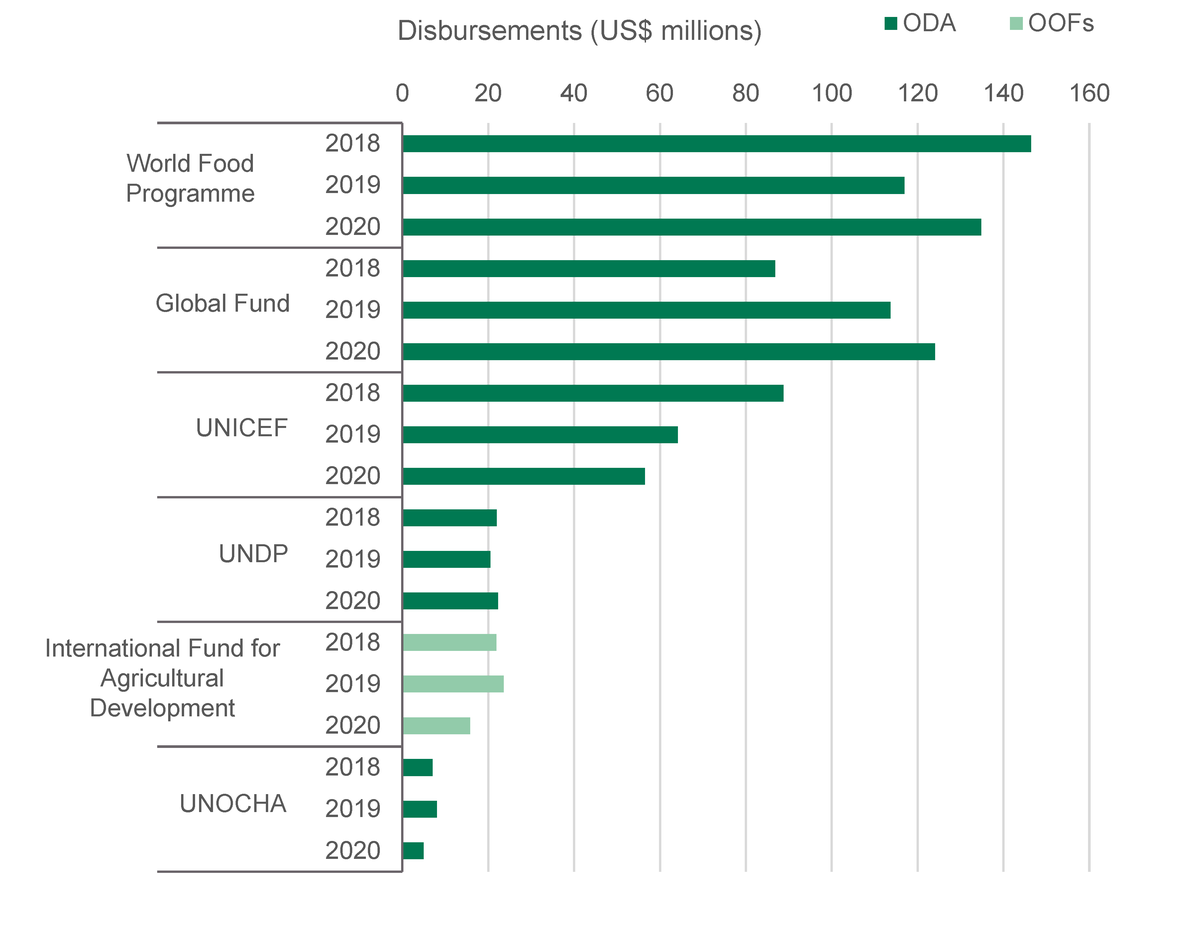
| ODA | OOFs | ||
| UNOCHA | 2020 | 4.945502 | |
| 2019 | 8.008589 | ||
| 2018 | 7.006018 | ||
|
International Fund for Agricultural
Development |
2020 | 0 | 15.75064 |
| 2019 | 0 | 23.61049 | |
| 2018 | 0 | 21.91223 | |
| UNDP | 2020 | 22.23687 | 0 |
| 2019 | 20.48792 | 0 | |
| 2018 | 21.93537 | 0 | |
| UNICEF | 2020 | 56.44048 | 0 |
| 2019 | 64.13977 | 0 | |
| 2018 | 88.74708 | 0 | |
| Global Fund | 2020 | 124.0336 | 0 |
| 2019 | 113.6438 | 0 | |
| 2018 | 86.84576 | 0 | |
| World Food Programme | 2020 | 134.8127 | 0 |
| 2019 | 116.8954 | 0 | |
| 2018 | 146.4172 | 0 |
Source: Development Initiatives based on IATI data.
Bilateral donors
While five of the 15 bilateral donors increased their contributions by between 8.3% and 41.8% between 2018 and 2019, only three donors increased their contributions between 2019 and 2020: EC (23.4%), Denmark (15.5%) and Sweden (8.0%) (Figure 5).
Figure 5: Bilateral donor aid disbursements, January to December, 2018 to 2020
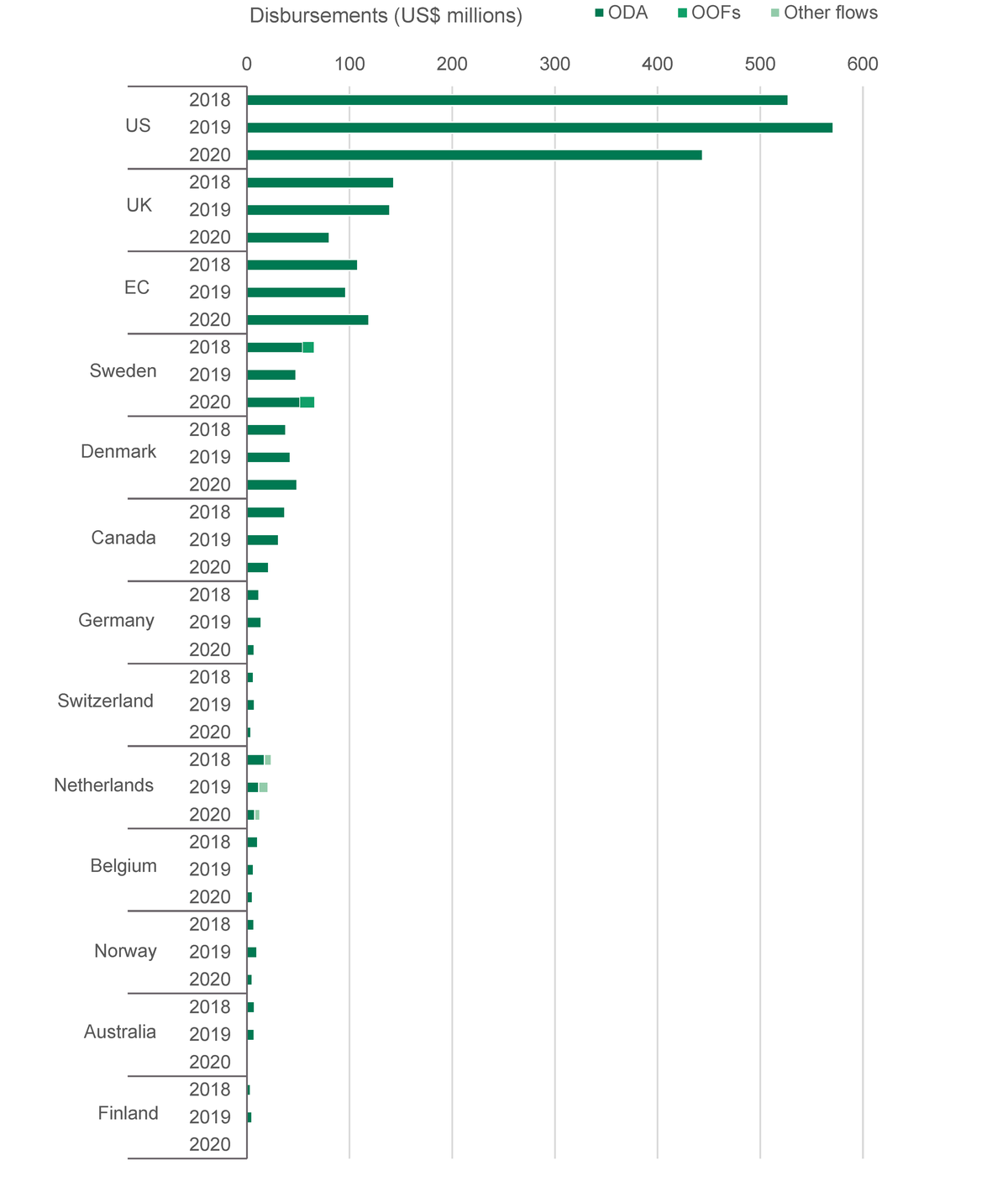
| ODA | OOFs | Other flows | ||
| Spain | 2020 | 0 | 0 | 0 |
| 2019 | 0 | 0 | 0 | |
| 2018 | 0 | 0 | 0 | |
| New Zealand | 2020 | 0 | 0 | 0 |
| 2019 | 0 | 0 | 0 | |
| 2018 | 1 | 0 | 0 | |
| Finland | 2020 | 0 | 0 | 0 |
| 2019 | 5 | 0 | 0 | |
| 2018 | 3 | 0 | 0 | |
| Australia | 2020 | 0 | 0 | 0 |
| 2019 | 7 | 0 | 0 | |
| 2018 | 7 | 0 | 0 | |
| Norway | 2020 | 5 | 0 | 0 |
| 2019 | 10 | 0 | 0 | |
| 2018 | 7 | 0 | 0 | |
| Belgium | 2020 | 5 | 0 | 0 |
| 2019 | 6 | 0 | 0 | |
| 2018 | 11 | 0 | 0 | |
| Netherlands | 2020 | 8 | 0 | 5 |
| 2019 | 12 | 0 | 9 | |
| 2018 | 17 | 0 | 7 | |
| Switzerland | 2020 | 4 | 0 | 0 |
| 2019 | 7 | 0 | 0 | |
| 2018 | 6 | 0 | 0 | |
| Germany | 2020 | 7 | 0 | 0 |
| 2019 | 14 | 0 | 0 | |
| 2018 | 12 | 0 | 0 | |
| Canada | 2020 | 21 | 0 | 0 |
| 2019 | 31 | 0 | 0 | |
| 2018 | 37 | 0 | 0 | |
| Denmark | 2020 | 49 | 0 | 0 |
| 2019 | 42 | 0 | 0 | |
| 2018 | 38 | 0 | 0 | |
| Sweden | 2020 | 52 | 14 | 0 |
| 2019 | 48 | 0 | 0 | |
| 2018 | 54 | 11 | 0 | |
| EC | 2020 | 119 | 0 | 0 |
| 2019 | 96 | 0 | 0 | |
| 2018 | 108 | 0 | 0 | |
| UK | 2020 | 80 | 0 | 0 |
| 2019 | 139 | 0 | 0 | |
| 2018 | 143 | 0 | 0 | |
| US | 2020 | 444 | 0 | 0 |
| 2019 | 571 | 0 | 0 | |
| 2018 | 527 | 0 | 0 |
Source: Development Initiatives based on IATI data.
Note: See the data set that accompanies this report for additional detail on bilateral aid disbursements.
What is the sector focus of aid disbursements from 2018 to 2020?
International financial institutions
- Despite the huge resource gap in the health and humanitarian sectors in 2020, IFIs prioritised allocation to the governance and security, agriculture and food security and education sectors in 2020. Allocation to these sectors generally increased consistently between 2018 and 2020 (Figure 6). [3]
- Notably, the infrastructure sector had the highest allocation share (36.5%) in 2018 and the second highest share (22.4%) in 2019 after agriculture and food security. However, allocations consistently dropped in the period under review.
- The biggest percentage increases in the period reviewed were witnessed in the banking and business sectors between 2019 and 2020 (1,355.7%), other social services between 2018 and 2019 (1,094.7%) and agriculture and food security (1,180%) over same period. The increases were driven by World Bank contributions.
Figure 6: IFI aid disbursements by sector, January to December, 2018 to 2020
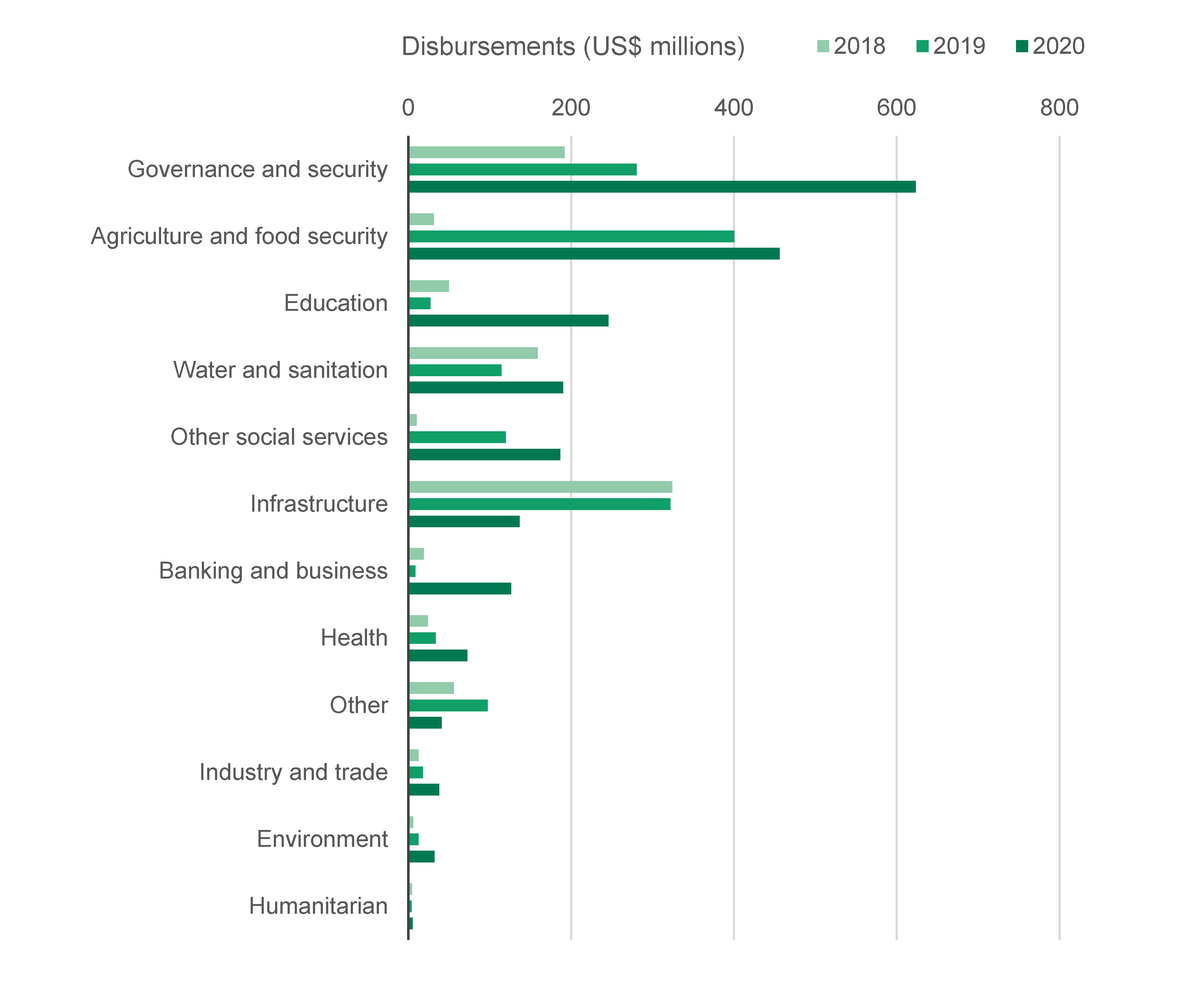
| 2020 | 2019 | 2018 | |
| Humanitarian | 5 | 4 | 4 |
| Environment | 32 | 12 | 6 |
| Industry and trade | 38 | 18 | 12 |
| Other | 41 | 97 | 56 |
| Health | 72 | 34 | 24 |
| Banking and business | 126 | 9 | 19 |
| Infrastructure | 136 | 322 | 324 |
| Other social services | 186 | 120 | 10 |
| Water and sanitation | 190 | 114 | 159 |
| Education | 246 | 27 | 50 |
| Agriculture and food security | 456 | 400 | 31 |
| Governance and security | 623 | 280 | 192 |
Source: Development Initiatives based on IATI data.
Note: Other = includes any other sector not mentioned.
Multilateral donors
- Multilateral donors’ sector prioritisation mirrors that of bilateral donors (Figure 7).
- Multilateral donors prioritised allocation to the health, humanitarian and agriculture and food security sectors in the three years reviewed.
- Only one of the three sectors – health – had allocation increased consistently in the three years reviewed (2019, 4.7% and 2020, 1.1%).
- Allocations to the humanitarian sector dropped by 10.6% in 2019, before increasing by 18.9% in 2020. Moreover, contribution to the agricultural sector increased by 14.3% in 2019 and dropped 28.2% in 2020. [4]
- Significant increases were witnessed in the water and sanitation sector, whose allocation increased by 56.8% in 2019 and 48.1% in 2020. It should be noted that though the increase in 2020 represents the highest percentage increase in all the sectors in 2020, in volume terms it is very small. Other significant increases included the industry and trade sector, which increased 1,306.7% in 2019; however, allocations dropped 78.8% in 2020.
Figure 7: Multilateral donor aid disbursements by sector, January to December, 2018 to 2020

| 2020 | 2019 | 2018 | |
|---|---|---|---|
| Infrastructure | 1 | 2 | 2 |
| Industry and trade | 1 | 5 | 0 |
| Environment | 4 | 5 | 5 |
| Water and sanitation | 4 | 3 | 2 |
| Education | 7 | 9 | 21 |
| Other social services | 11 | 13 | 13 |
| Governance and security | 12 | 10 | 19 |
| Other | 15 | 16 | 15 |
| Agriculture and food security | 19 | 27 | 24 |
| Humanitarian | 139 | 117 | 131 |
| Health | 148 | 146 | 139 |
Source: Development Initiatives based on IATI data.
Note: Other = includes any other sector not mentioned.
Bilateral donors
- The health sector had the biggest share of allocation in volume terms in the three years reviewed. However, allocations fell by 31.1% between 2019 and 2020 despite health being the primary sector for use of ODA grants. [5]
- Allocation to the humanitarian sector, which had the second biggest allocation share in both 2018 and 2020, declined by 34.2% between 2018 and 2019 and increased 38.2% between 2019 and 2020. Notably, the second biggest allocation share in 2019 went to the agriculture and food security sector, which was allocated 14.0% of the bilateral aid contributed in 2019.
- Aid disbursements to the governance and security sector declined consistently in the period under review, dropping by 12.2% in 2019 and 16.0% in 2020.
Figure 8: Bilateral donor aid disbursements by sector, January to December, 2018 to 2020

| 2020 | 2019 | 2018 | |
|---|---|---|---|
| Infrastructure | 11 | 23 | 35 |
| Education | 19 | 35 | 40 |
| Water and sanitation | 20 | 33 | 37 |
| Industry and trade | 21 | 22 | 36 |
| Other social services | 21 | 19 | 16 |
| Banking and business | 23 | 13 | 13 |
| Environment | 37 | 56 | 57 |
| Other | 38 | 36 | 44 |
| Governance and security | 77 | 92 | 105 |
| Agriculture and food security | 117 | 140 | 100 |
| Humanitarian | 128 | 93 | 141 |
| Health | 303 | 439 | 366 |
Source: Development Initiatives based on IATI data.
Note: Other = Includes any other sector not mentioned.
Conclusion
The analysis has shown that while loans are increasing, grants are dropping. This trend is happening as Kenyan debt continues to rise to levels that threaten servicing sustainability. While borrowing will continue in the short term to compliment domestic resources available for budgeting, increasing borrowing will mean that Kenya has to contend with increasing debt service payments, which, considering that current debt payments are already larger than sectoral budgets, may limit the amount of resources available for budgeting.
The following are overarching conclusions from the analysis.
- Disbursements from IFIs grew consistently in the period reviewed, while those from bilateral donors and multilateral institutions were inconsistent over the same period.
- ODA contributed by IFIs grew consistently between 2018 and 2020, driven by the World Bank’s contributions. In contrast, ODA from bilateral and multilateral institutions was inconsistent in the same period, either decreasing or increasing in at least one year.
- While IFI loans have consistently increased between 2018 and 2020, grants from bilateral institutions have fallen. Decline in overall grant funding between 2019 and 2020 was partly driven by the decline in health grants, which would be a vital resource during the pandemic.
- While contributions from the top two bilateral institutions (the US and the UK) fell in 2020, contributions from the top five institutions (the US, the UK, EC, Sweden and Denmark) increased.
- IFIs prioritised allocation to the governance and security and agriculture and food security sectors, while bilateral and multilateral institutions prioritised the health and humanitarian sectors.
Appendix
Table A1: Key bilateral donors, IFIs and multilateral institutions used in the analysis of IATI disbursements
| Bilateral donors | IFIs | Multilateral institutions |
|---|---|---|
| Australian Aid | African Development Bank Group (AfDB) | Global Fund |
|
Belgium – Directorate-General for
Development Cooperation and Humanitarian Aid (DGD) |
World Bank | International Fund for Agricultural Development (IFAD) |
| Canada – Foreign Affairs, Trade and Development (DFATD) | United Nations Development Programme (UNDP) | |
| Denmark – Ministry of Foreign Affairs | UNOCHA – Central Emergency Response Fund (CERF) | |
| European Commission (EC) – Development and Cooperation – EuropeAid | United Nations International Children’s Education Fund (UNICEF) | |
| EC – Service for Foreign Policy Instruments (FPI) | United Nations World Food Program (WFP) | |
| EC – European Civil Protection and Humanitarian Aid Operations (ECHO) | ||
| Finland – Ministry for Foreign Affairs | ||
| Germany – Federal Foreign Office | ||
| Netherlands – Enterprise Agency (RvO) | ||
| Netherlands – Ministry of Foreign Affairs (DGIS) | ||
| Norway – Norway Agency for Development Cooperation (Norad) | ||
| Sweden – Swedish International Development Cooperation Agency (Sida) | ||
| Switzerland – Swiss Agency for Development and Cooperation (SDC) | ||
| UK – British Council | ||
| UK – Department for Business, Energy and Industrial Strategy (BEIS) | ||
| UK – Department of Health and Social Care (DHSC) | ||
| UK – Foreign, Commonwealth and Development Office (FCDO) | ||
| US – US Agency for International Development (USAID) |
Downloads
Notes
-
1
IATI standard, www.iatistandard.org/en/ (accessed 27 July 2021)Return to source text
-
2
IATI standard, www.iatistandard.org/en/ (accessed 27 July 2021)Return to source text
-
3
IATI standard, www.iatistandard.org/en/ (accessed 27 July 2021)Return to source text
-
4
IATI standard, www.iatistandard.org/en/ (accessed 27 July 2021)Return to source text
-
5
IATI standard, www.iatistandard.org/en/ (accessed 27 July 2021)Return to source text
Related content
Domestic financial flows in Kenya before and during Covid-19
This briefing tracks domestic revenue and spending to key pro-poor sectors in Kenya before and during the Covid-19 pandemic.
Kenya’s Covid-19 budget: Funding for health and welfare
How the new budget will support Kenya's health and welfare systems as they deal with the impact of Covid-19 (coronavirus) and scale up universal health coverage
Socioeconomic impacts of Covid-19 in Kenya
How has coronavirus impacted housing, transport, food security and the labour force in Kenya? This paper looks at government measures initiated in these areas.
